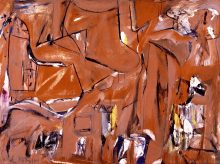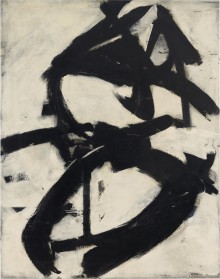Collection
Gallery Location: Friendships in the New York School Tour (4 works)
 The 1950s and ’60s in modern American art were
defined by one of the most influential yet informal
groups in art history: the New York School. This group
of painters, writers, and musicians sought to
differentiate themselves from the School of Paris, which
included Picasso, Matisse, and Chagall. Their network
of interactions made significant contributions to
American modern art, particularly in the development of
Abstract Expressionism. The movement blended
post–World War II industrialism with the emotional
intensity of the destruction of the war. Artists
experimented with color, technique, and figuration,
focusing on expressing their inner world.
The 1950s and ’60s in modern American art were
defined by one of the most influential yet informal
groups in art history: the New York School. This group
of painters, writers, and musicians sought to
differentiate themselves from the School of Paris, which
included Picasso, Matisse, and Chagall. Their network
of interactions made significant contributions to
American modern art, particularly in the development of
Abstract Expressionism. The movement blended
post–World War II industrialism with the emotional
intensity of the destruction of the war. Artists
experimented with color, technique, and figuration,
focusing on expressing their inner world.
The New York School was not a club, but rather a
network of artists who met in cafes, bars, and studios to
showcase their techniques, receive advice, and share
their work. The influence of the New York School has
continued throughout the development of modern art,
with contemporary artists resembling the threads of
abstraction, color, technique, and figuration in their
works. In this tour, we encourage you to examine works
from some of the most influential artists of the school,
with a focus on the threads that connect their works to
each other, or encourage separation.
—Irmak Ersoz ‘24
View Friendships in the New York School Self-Guided Tour Card
Please note: The museum invited Stanford students to develop themed tours that reflect their perspectives and interpretation of collection works. Each student perspective expresses the individual point of view of its author.





